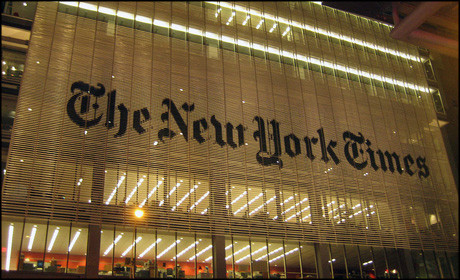
"It's clear that the tenurable model of tiny little navigation links that run across the top is not very well suited to the way people are consuming and reading these days. We have a lot more exploration to do."
John Niedermeyer, as lead designer of digital news at the New York Times, has spent much of the last month considering how people best consume online content, in anticipation of the latest issue of the Times's Magazine.
The Sunday supplement has been re-imagined for the web and an online version of this month's 'innovations issue' went live on Friday, featuring 48 pages of responsive magazine content, complete with responsive advertising, built through HTML5.
"When you translate things for digital, frequently there's a loss of a lot of the things that make a magazine such a great thing to thumb through," explained Niedermeyer, speaking to Journalism.co.uk.
"So one of the goals of this project was to bring part of that art direction – typography, photography, the sort of nice magazine lay out – to the digital side."
The tactile nature of this project – creating something "that was designed to be touched first" – was central to making it attractive for mobile and tablet users; incorporating gesture navigation to swipe between content either on a mobile or tablet device or using keys on a desktop.
"We really wanted to be able to design something that would be a great experience for more and more readers coming to us from all these different devices and we thought we could explore that," he said.
For web designers, creating pages that can quickly adjust to different screen sizes is still the most complex issue – "we still don't have the tools that a print designer would have" said Niedermeyer.
Building adverts that could adapt to window adjustments or alternative screens was an additional test. "I think as we were throwing out all the assumptions about templates and the way that we would present the content, we also wanted to challenge ourselves to come up with a different kind of ad experience," he said, "one that would feel much more at home in our apps."
HTML5 is still a relatively young language for designing and building content and as such Niedermeyer says it demands "a lot of work, fast" for designers and programmers who want to make pages that offer the best experience to the reader. But what is the reader looking for?
"First and foremost they want to be able to read the content," said Niedermeyer, "especially when we're talking about smaller and smaller devices. Every bit of 'crust' that is added, or promotion, or all of these things sort of detract from actually consuming and experiencing reading so I think that's something that readers are looking for.
"It's the age old question of 'can I read the content? Can I find things I might be looking for?'. I just think that the patterns have to change and the hardware changes in these devices have enabled us to do things that we couldn't do 10 years ago."
The attractive, responsive and intuitive nature of these HTML5 projects – of which Snow Fall and Firestorm are much larger, more complex versions – are at the forefront of web design for presenting content digitally. Yet the developing technology's uses is still at an early stage, said Niedermeyer.
"I think everyone in the industry has to pick and choose where to apply this level of effort," he said. "This is about a week of really intense work to get this out the door and you can't do that with every story or every feature.
"But I think there's enormous potential to improve the templates that we use to just run articles as they're published every day."
Free daily newsletter
If you like our news and feature articles, you can sign up to receive our free daily (Mon-Fri) email newsletter (mobile friendly).
Related articles
- Dmitry Shishkin, new CEO of Ringier Media International, on leading growth across 80 media brands
- The Forward scrapped its paywall and generated 37 per cent more revenue
- Five media sustainability lessons from The Economist
- Seasoned reporting: charting changing tastes in food journalism
- The summer 2024 journalism grants roundup











